Category: Air National Guard
Join us for our Gowen Field Memorial Park brick laying dedication video
IDAHO AIR NATIONAL GUARD’S 124TH FIGHTER WING DEPLOYS TO SOUTHWEST ASIA
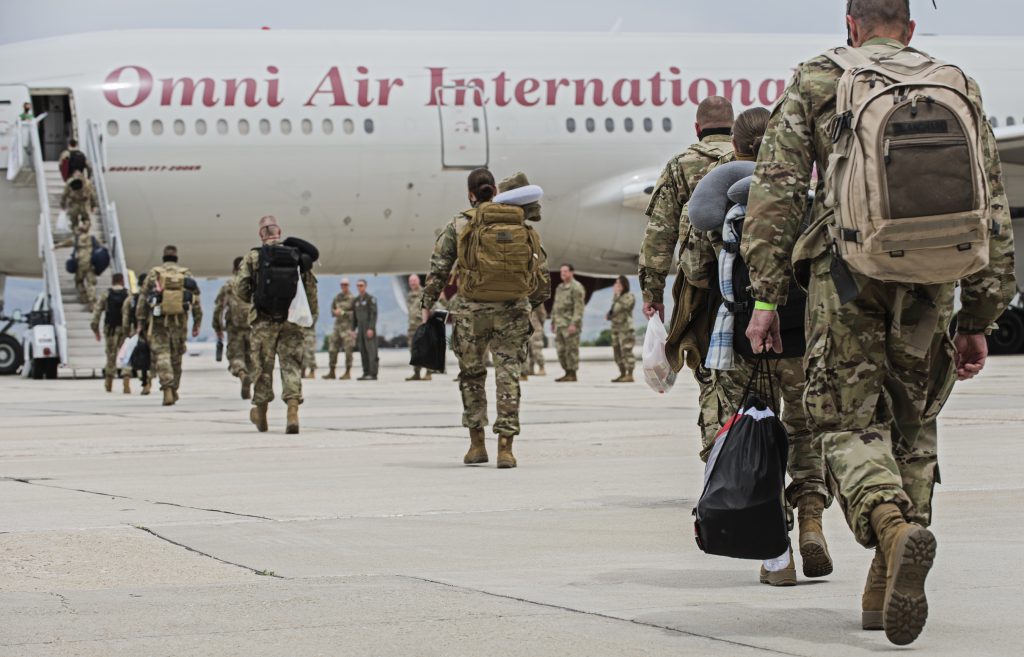
The Idaho Air National Guard deployed to various locations throughout Southwest Asia in support of combat operations on May 11.
More than 400 members of the 124th Fighter Wing, based at Gowen Field, will continue to deploy throughout the spring and summer in support of Operations FREEDOM’S SENTINEL, INHERENT RESOLVE and NEW NORMAL.
“We recognize the impact this mission will have on our community and we deeply appreciate the sacrifice of Idaho’s service members,” Idaho Gov. Brad Little said. “This deployment once again displays the commitment of the 124th Fighter Wing and its members, as well as the dedication demonstrated by the community of families, state and local leaders, neighbors and employers who provide unwavering support to our service members.”
The deployment is the wing’s second largest deployment and includes multiple aircraft, pilots, security forces, maintenance and medical personnel, and various other support staff. The official sendoff took place May 11 with the departure of the main body of personnel.
Deploying Airmen received farewell comments from Idaho National Guard leadership, including Little, Idaho’s commander in chief, and the Adjutant General of Idaho Maj. Gen. Michael Garshak.
Since 1946 the Idaho Air National Guard has flown fighter aircraft in the defense of our nation. The last large scale deployment in the 124th Fighter Wing was in 2016 in support of combat operations against ISIS and it was the largest deployment in the wing’s history. Deployments typically last up to 180 days and impact not only the families of Airmen, but the community as a whole.
Idaho National Guard helps in a time of need during the COVID-19 pandemic
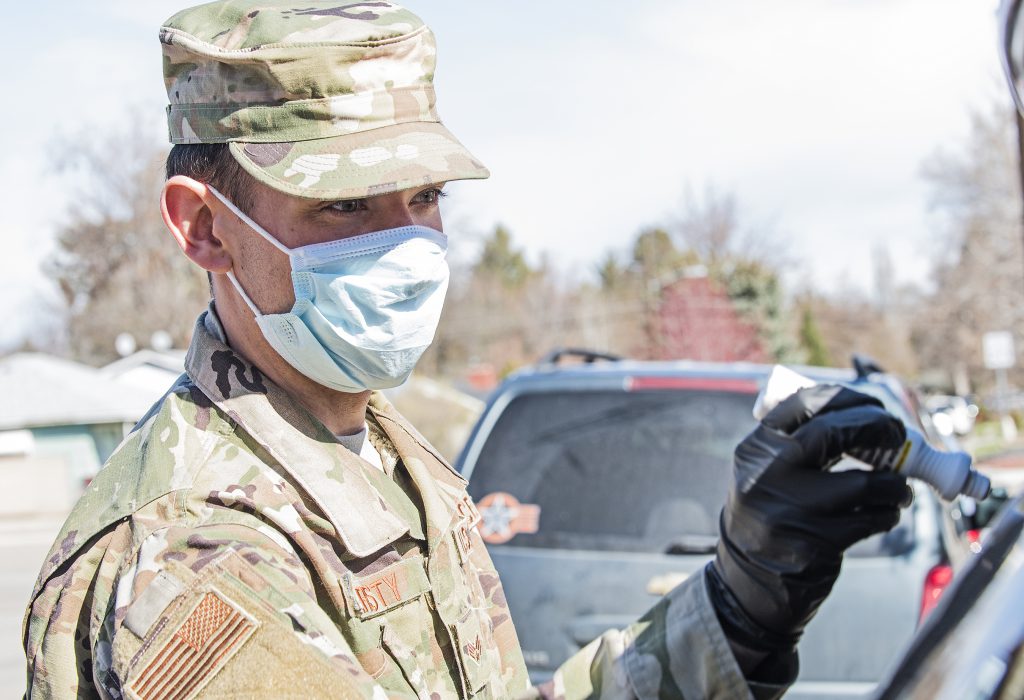
By Master Sgt. Becky Vanshur
Idaho Military Division Public Affairs
BOISE, Idaho – More than 40 Idaho National Guard Soldiers and Airmen are helping food bank workers keep up with increased demand as Idahoans start to feel the effects of the COVID-19 pandemic.
“We are so delighted to have this support from the Idaho National Guard,” said Karen Vauk, the Idaho Foodbank’s CEO and president. “We have to get more food in and more food out to support our communities across the state. We needed more manpower, so we called upon the National Guard.”
Citizen-Soldiers and Airmen were placed on state active duty orders in late March and assigned to work at the Idaho Foodbank’s Boise, Lewiston and Pocatello locations.
“We have more than 4,000 members in the Idaho National Guard,” said Maj. Gen. Michael Garshak, commander, Idaho National Guard. “We respond when the state, county or city organizations’ capacities are overwhelmed or stretched to the limit and they ask us to come in and help.”
Vauk requested additional assistance through the Idaho Office of Emergency Management after she noticed a significant increase of need in the food supply throughout Idaho, which was causing her operations to be spread thin.
Citizen-Soldiers and Airmen are also assisting at Boise’s St. Vincent de Paul Food Pantry by handing out donated groceries to those in need. The Idaho Foodbank donates food to pantries like St. Vincent de Paul as part of the Feeding America program.
“Before COVID-19, what we would see here at the pantry would be an average of maybe 1,100 families per month,” said Ralph May, executive director of St. Vincent de Paul. “During this crisis, we are seeing close to 2,300 families per month for now. We are seeing a little more than double and some days we are seeing three times the amount of families we would normally see in a day.”
Citizen-Soldiers and Airmen are assisting employees and volunteers with loading and unloading trucks, boxing and sorting donated food, helping load food into people’s cars and making deliveries to several of its 400 community-based partners throughout the state.
“Missions like this give people another reason to want to join the National Guard,” said Garshak. “Not only are they trained and prepared to serve our nation at times of war, but they are also ready and available to come to the aid of local communities and citizens in times of need.”
Family service: Father, three children serve together
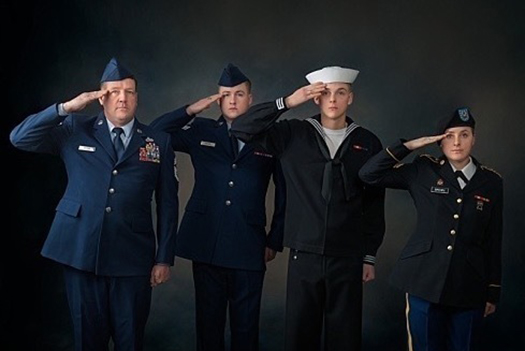
Story by Airman 1st Class Taylor Walker
124th Fighter Wing
In 1986, Idaho Air National Guard Command Chief Master Sgt. Sid Brown was itching to leave the small town of New Plymouth, Idaho. With the financial burden of college heavy on his mind, he met with an Air Force recruiter in Ontario, Oregon, He quickly found himself in uniform, working as an F-16C weapons load crew member at Ramstein Air Base, Germany.
He didn’t know it at the time, but he had just embarked on a career that would last more than three decades and see three of his children follow him into military service. As the Idaho Air National Guard’s senior enlisted leader, Brown is ending his career as his children begin their own careers, each in a different military branch.
“It means a lot to me to have my children serving,” Sid said. “I believe everyone who is able should serve in some capacity – even if they don’t join the military – and I’m very happy they’ve all chosen unique paths to do that.”
The first of Sid’s kids to join the military was Everett Brown, a traffic management specialist with the Idaho Air National Guard’s 124th Fighter Wing at Gowen Field. Now a senior airman, Everett said the military is engrained in his family history.
“We have a very long bloodline of military in our family, all the way back to when they stormed the beaches of Normandy, to Vietnam and the world wars,” said Everett. “The tradition has carried on from generation to generation. It’s an established part of our lives.”
For Everett, joining the Idaho Air National Guard was a way to honor his father and the experiences he had as a child on Gowen Field.
“As a kid, I watched my dad come home from deployments and saw the respect and pride he had and I wanted to feel that way,” Everett said. “My dad has always been my hero and it didn’t matter what branch I ended up joining, I just wanted to work hard the same way he did.”
Everett left for basic training the same day his sister, Kassandra, enlisted in the Idaho Army National Guard.
Cpl. Kassandra Brown is an ammunitions specialist in Golf Company, 145th Brigade Support Battalion. Although she wasn’t initially sure what branch she wanted to join, she knew the military was where she belonged.
“Joining the military felt like something I needed to do,” said Kassandra. “None of my friends were surprised when I finally joined. I feel like I’ve always had that decision in my heart.”
Kassandra said between the conflicting schedules and excessive pride, there’s a bittersweet feeling when it comes to having a family full of military members.
“I feel very proud of my family, but also scared at the same time because you never know what will happen to them,” she said. “But we all have cool stories to share. In our family you always have someone to talk to. You always have someone to relate to.”
Everett and Kassandra’s brother Wesley, who joined the Navy in June 2019, agreed that the support from their family is invaluable.
“They really understand what I’m going through, especially my dad who has had active duty experience,” said Wesley. “He takes time to answer all of my questions.”
Seaman Wesley Brown is a hospital corpsman at Wayne Caron Clinic, Camp Lejeune, North Carolina. Although his mom’s side of the family has a rich naval history, Wesley’s motivation for joining the military had less to do with his family’s history of service.
“I mostly wanted to branch out from Idaho and experience the world through a different lens than the rest of my family,” he said.
Regardless of their selected branch or individual reasons for joining, Wesley said the military establishes a common thread between him and his siblings.
“I take pride in my family because we’re all doing our part to serve our country,” said Wesley. “We come from a good background with strong morals.”
Although Sid has decades of experience and sits in a highly regarded position, he largely keeps his influence to himself when it comes to his children.
“I do my best to stay out of their careers,” Sid said. “Good, bad or indifferent, it’s their path.”
According to a 2013 Pentagon report, more than 82% of recruits across the Army, Navy and Air Force have a family member who has served in the military. Whether that’s the case or not for a military hopeful, Sid emphasized that it’s important for parents to be supportive of their children’s decisions.
“The military is a great career path,” he said. “Your kids will learn new skills, get great benefits and a great education. They’ll have to stay off drugs and they’ll potentially see the world. Don’t be afraid. Don’t stifle their decisions.”
Brother, sister serve together
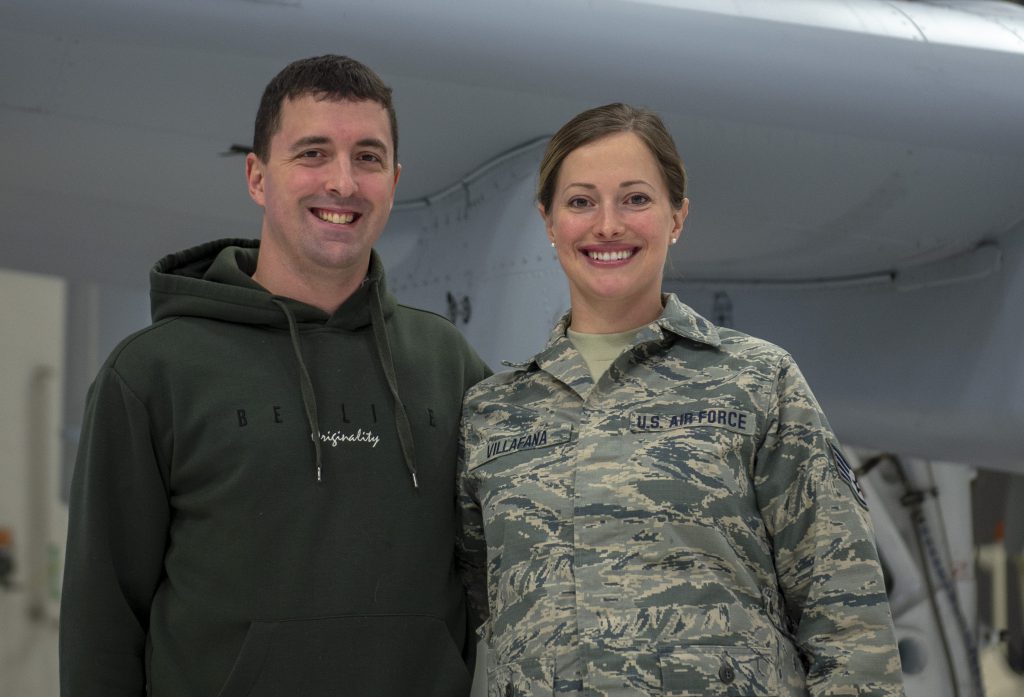
By Ryan White
124th Fighter Wing Public Affairs
Staff Sgt. Mason Allen and his sister, Staff Sgt. Camas Villafana, were both responsible for each other’s decisions to become Idaho National Guardsmen. Allen, who was the first to join the military, chose to enlist in the active duty Air Force in 2014. He then influenced his sister’s decision to join the Idaho Air National Guard in 2015. Now the siblings have come full circle. This year, Villafana influenced her brother’s recent decision to join the IDANG after leaving active duty.
One would think Allen, a former aircraft integrated avionics specialist for the A-10 Thunderbolt II, would be joining the IDANG to continue working on the A-10s. However, he is following in his sister’s footsteps and the two are serving side-by-side at the 124th Medical Group.
“I was considering joining the National Guard,” said Allen. “After talking to my sister, it allowed me to see what was available to me at this unit.”
While Villafana was looking into options for Allen, she learned about a recent vacancy her brother would be interested in. Allen did some research and decided she was right. Now, he is enlisted as the MDG’s newest biomedical equipment specialist.
“The job title alone tells me that it’s going to be more mechanically inclined,” said Allen. “I feel like that is something I became exceptional at in the job I had on the active duty side. I am excited to learn how to put those skills to use at a different job and also learn a whole new set of skills that I can apply later in a civilian job.”
Allen will have to attend a technical training school, for about a year and a half, sometime after September. Until then, he will be working at the MDG starting this month. For the first time, Allen and Villafana will be working together.
Villafana first started working at the MDG in 2015, when she became a part of the IDANG family. She is currently working full-time until April, just in time to begin planting and irrigating on the farm she and her husband operate in Wilder, Idaho. They grow sugar beet row crops. She says she appreciates the flexible schedule that comes along with the IDANG, allowing her to farm. This was one of the benefits that originally appealed to her about joining IDANG.
“I wanted to join the National Guard since high school,” said Villafana. “It kind of fell off my radar until after I graduated [college], when Mason joined the active duty Air Force. I started thinking about it more and talking to Mason. He was the one who helped me understand the different ins and outs of the different branches. I knew I wanted to join the Air Force, but I didn’t want to leave Boise.”
Villafana ultimately decided that joining the IDANG was the right choice for her and she’s glad she did. She says she enjoys the tight-knit relationships she has, which she may not have been able to develop, had she joined active duty instead.
Those close relationships and the flexibility with the IDANG, along with a new job opportunity, were ultimately what sold her brother on joining. Allen is looking forward to living closer to his family and continuing his Air Force career as an Idaho Guardsman alongside his sister.
A day in the life of an A-10 fighter pilot
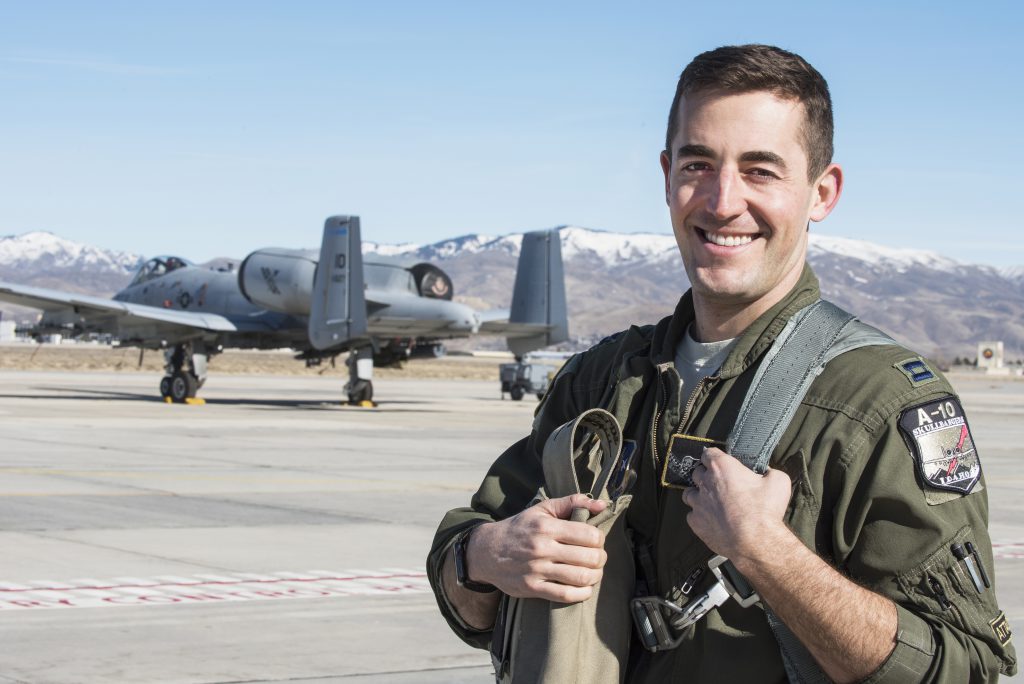
By Master Sgt. Becky Vanshur
Idaho Military Division Public Affairs
GOWEN FIELD, Idaho — Spend a day flying with Capt. Mike Shufeldt, one of the Idaho National Guard’s A-10 Thunderbolt II pilots, and feel firsthand what it is like to be an A-10 fighter pilot.
He can smell the strong scent of coffee brewing from the kitchen, as he brushes his teeth. It’s early in the morning, but his dog, Poppy, sits at his heels patiently waiting with a ball in her mouth and tail wagging. Shufeldt grabs his thermos of coffee, throws the ball a couple of times for Poppy, pats her furry head and walks out the door.
The commute across the Treasure Valley isn’t too bad as he heads down the interstate, even with the sun shining in his eyes as it rises above the beautiful Idaho foothills. Shufeldt approaches the main gate of Gowen Field, Boise’s Air Terminal and National Guard Base, with a smile on his face. Today is a good day to fly the mighty A-10 over the nearby Orchard Combat Training Center.
Shufeldt enters the building of the 190th Fighter Squadron and prepares for his day. He gets dressed in his flight G-suit, then his harness for his seat and parachute, and he grabs his high-tech flight helmet. Preparing for his flight and the training mission can take up to two hours. At the operations desk, he listens to his step brief. Today, he is called Bang 11.
The step brief is for him and his wingman, the additional pilot flying the second aircraft on this morning’s training mission. They are briefed on the weather, coordinates, weapons and the close air support mission they are about to fly.
“Bang 11, you are clear to step. Attack,” are the last words said before he heads out to the flight line where his A-10, commonly referred to as a Warthog, is patiently waiting. It is nearing 9 a.m. as he begins the 45-minute preflight check. He walks around his A-10, scanning for any visible issues.
“I do a full preflight inspection on the outside of the jet, to make sure there isn’t anything I see wrong,” said Shufeldt. “Usually there isn’t because our crew chiefs and our maintainers are really good. They are the best, actually.”
He climbs up the ladder and straps into his seat. He and his crew chief turn on the auxiliary power unit and fire up the twin turbine engines. “Clear on one,” said Shufeldt. “Good start on one,” is the response. “Clear on two.” “Two is clear,” is echoed back to him and the two engines are now fired up.
“We check everything, from the brakes to the rudders to the digital systems inside the jet,” said Shufeldt.
Both Warthogs are now ready for flight. “Pull the chalks, see you soon,” said Shufeldt. He disconnects with his crew chief, they salute and he taxis to the runway, stopping near the end to have his A-10’s weapons armed.
The powerful Warthogs line up. Shufeldt is out front. Once cleared for takeoff, he steps firmly on the brakes and runs up the engines. As he eases the throttles forward, the 12-and-a-half-ton beast starts to shake as it reaches nearly 20,000 pounds of thrust.
After checking his gauges and instruments, he pushes the throttles to maximum and releases the brakes. The mighty Warthog gains speed quickly, reaching approximately 150 miles per hour before he pulls back on the stick and the tires leave the runway.
He is up in the air. He takes a deep breath. A moment of calm, but it is short-lived as he begins his in-flight checks and focuses on the mission. He flies toward the target area.
The sun is just above and to the left, the heat from its rays beating down on his neck, the only portion of skin that is exposed.
He can see several dirt roads below in the vast desert and sagebrush-filled land of the OCTC as he approaches the target area near the ground troops below. They are providing ground support while shooting training targets.
“Bang 11 in from the south, guns,” said Shufeldt. “Bang 11, cleared hot,” said the ground troop on the radio below, providing Shufeldt clearance to shoot the 30 mm Gatling gun. “Bang 11, good hits,” is heard after the rounds are fired.
After expending all weapons, he has completed the training mission. Before flying back to Boise, the pilots check each other’s aircraft for any issues. This is called a battle damage check. The A-10s fly wingtip to wingtip, then Shufeldt dips below his wingman’s aircraft and looks up, checking the belly of the A-10. They switch positions and fly back in formation to Gowen Field.
Shufeldt lands, taxis the satisfied Warthog back to the flight line and parks in the same spot in which he started. He reverses the order of the prefight for the shutdown procedures with the crew chief. Once inside, he debriefs the mission with his wingman. It is nearing 1:30 in the afternoon and he is hungry. He warms his lunch, a stir-fry he cooked the night before.
Pilots, like any Airman, have additional military training and duties. He completes these, spends an hour at the gym and heads home.
He walks through the front door with barely enough time to close the door behind him as Poppy jumps up as high as she can, almost knocking him over. Shufeldt is home now after a day in his life as an A-10 fighter pilot.
Leadership is the most important component in any organization
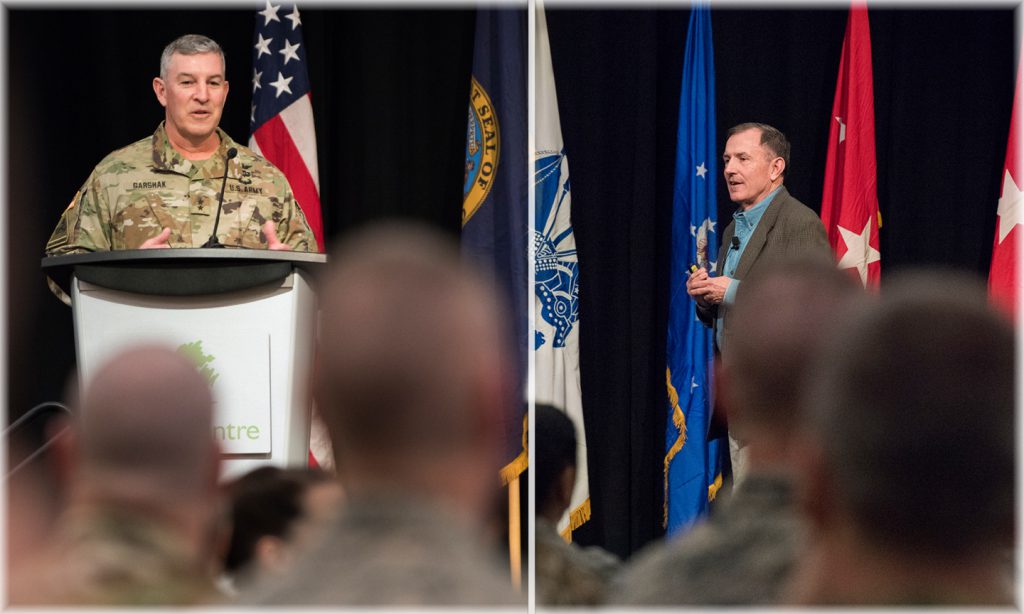
By Master Sgt. Becky Vanshur
Idaho Military Division Public Affairs
The Idaho National Guard held its annual adjutant general’s leadership conference focusing on what makes a successful leader. The joint conference on Feb. 22, held at the downtown Boise Centre, brought together leaders from the Idaho Army National Guard and the Idaho Air National Guard with several keynote speakers and informative breakouts for the daytime event, followed with the Family Programs Awards Ceremony and Banquet the same evening.
“Leadership is the most important component in any organization,” said Maj. Gen. Michael Garshak, adjutant general of Idaho. “We have tremendous leaders throughout the Idaho National Guard. This is not about fixing what may be broken, but continuing to grow and develop as leaders to make our organization even better. Our Soldiers and Airmen deserve the best leadership we can provide.”
Mr. Tom Greco was the daytime event’s primary speaker. He is Idaho’s civilian aide to the secretary of the Army and a retired combat veteran.
“Everything rises and falls on leadership,” said Greco. “If you don’t have the right location, you move. If you don’t have the right people in your organization, you go out and hire them. If you have the right people, but they don’t have the right skills, you train them. But if you don’t have the leadership in your unit, you are sunk. Everything rises and falls upon leadership.”
His advice on successful leadership can be summed into a list: leaders have a vision, leaders lead with integrity, leaders are credible, leaders are decisive, leaders are communicators, leaders are risk-takers, leaders are mentors, leaders are generous, leaders have balance, leaders are listeners and leaders are learners.
The night banquet event was about recognizing the accomplishments of the Idaho National Guard, and taking the time to recognize outstanding contributions by individual members, volunteers and family members within the organization.
The ceremony recognized the recipient of the 2019 Governor’s Outstanding Unit Award, given to Detachment 2, Charlie Company, 1-168th General Support Aviation Battalion. The annual award is given to a high performing unit whose contributions exemplify the highest levels of excellence.
Family Programs also awarded Amanda Signorio, 25th Army Band, Lt. Col. Christina Taylor, Cassandra Rzepa, Colter McBride, Sgt. 1st Class Dustin Dyer, and Newby-Ginnings a supportive business located in Northern Idaho, founded by Theresa Hart for outstanding achievement and selflessly devoting hundreds of hours of volunteer service.
The annual Clinton R. Taylor Integrity in Leadership award was presented to Lt. Col. John Williams from the 124th Operations Squadron, Capt. William Miller from the 2nd of the 116th Cavalry Armor Battalion, Senior Master Sgt. Shallan Prickett from the 124th Logistics Readiness Squadron and 1st Sgt. Sheldon Stace from Charlie Company 145th Brigade Support Battalion. The Integrity and Leadership award is given to individuals with exemplary traits in trust, mentorship, attitude, empowerment, resiliency, courage, professionalism and community service.
Putting the pieces together: TACP share experiences with 124th Fighter Wing Airmen
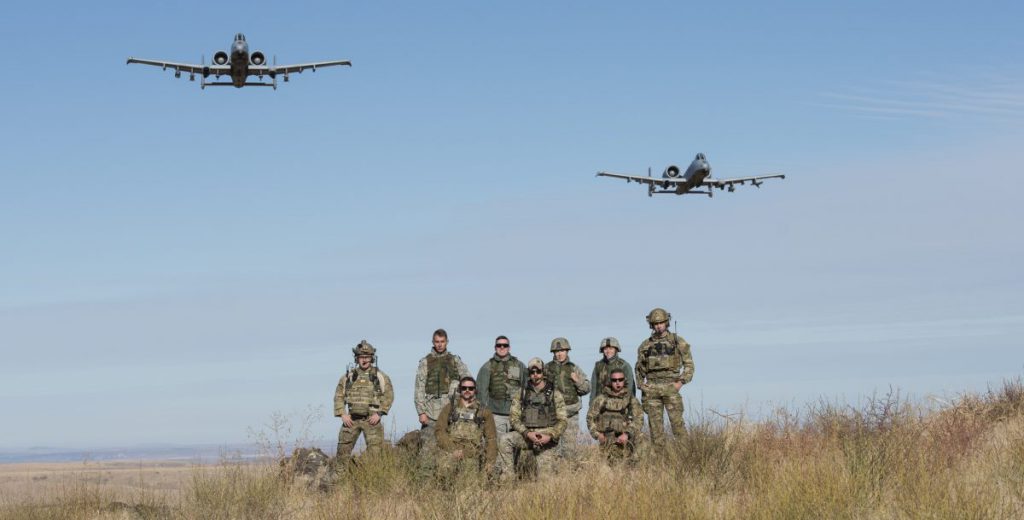
Story by Airman 1st Class Taylor Walker
124th Fighter Wing
GOWEN FIELD, Idaho (October 5, 2019) – Airmen from the 124th Maintenance Squadron and 124th Medical Group joined Tactical Air Control Party Airmen from the 124th Air Support Operations Squadron for a show of force, October 5, at the Saylor Creek Bombing Range, Idaho.
The primary role of TACP Airmen from the 124th ASOS is to provide close air support by directing combat strike aircraft against enemy targets, but that role continues to expand.
“As a TACP, we focus on deconflicting airspace and preventing fratricide and collateral damage,” said Staff Sgt. Brandon Wells, a Joint Terminal Attack Controller in the 124th ASOS. “Being a JTAC isn’t just about the bomb hitting the ground or the gun going off, there are a lot of minor steps and critical thinking that occurs for every process we encounter.”
Planning for a training mission begins more than three hours before time on target. TACP Airmen conduct briefings, perform safety checks and develop missions that ensure opportunities to practice skills used in real-world scenarios.
“This job is 90 percent planning,” said Wells. “Our newest Airmen will spend days focused solely on planning missions, problem solving and figuring out how to make sure communication between ground force commanders, team leaders and comrades are on point so everyone knows their role and stays safe.”
For traditional guardsmen, time is precious and mission planning must be accomplished alongside additional duties.
“A JTAC is a JTAC regardless of whether you’re in the National Guard or on active duty,” said Tech. Sgt. Justin Clark, a JTAC in the 124th ASOS. “We have the same requirements as everyone else and less time to do it. We all have multiple additional duties. Some even have five or six.”
With such a small window available to accomplish mission readiness, it’s hard to imagine the ASOS adding more to their plate, but they’re ready to branch out.
“We understand the other people on base are part of our team and have responsibilities that enable us to successfully do our job,” said Clark. “When people have the opportunity to come out and see what we do, we try to make the most of it, but we want to do that with other shops as well so we can have a better understanding of how each piece of the puzzle fits together and build a more rounded understanding of our extended team.”
The key, said Clark, is to avoid the tunnel vision that can result from staying in one shop and not venturing out to explore.
“Until we can experience what other squadrons do, we can’t make assumptions,” said Wells. “We’re all one team.”
Idaho National Guard conducts engineer, medical and leadership exchange in Cambodia
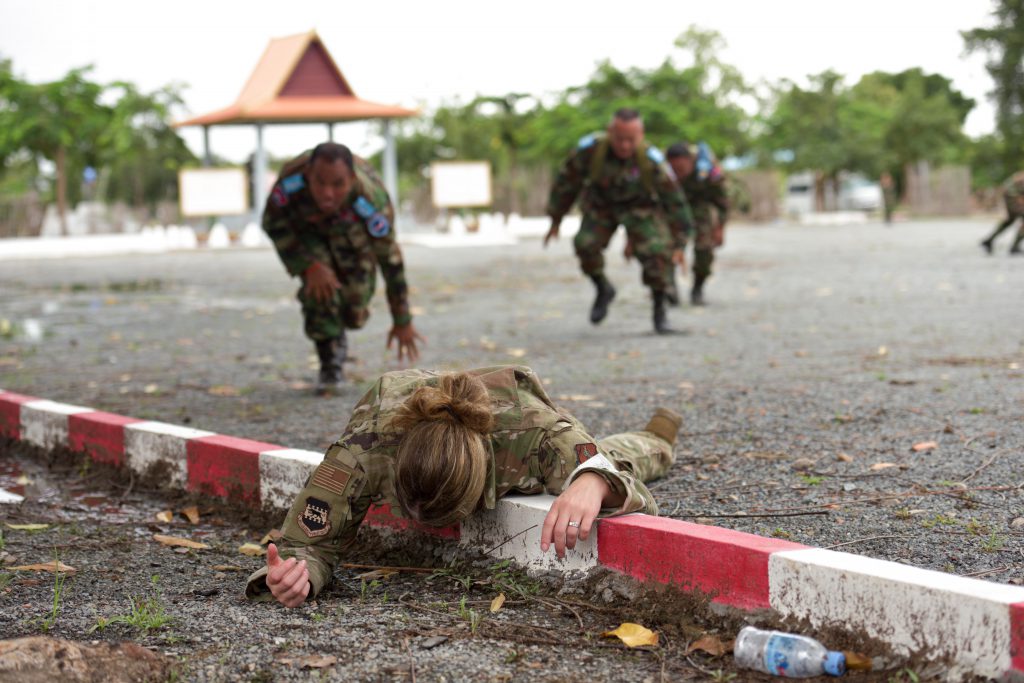
PHNOM PENH, CAMBODIA
Story by Capt. Robert Taylor
Idaho Army National Guard
Idaho National Guard Soldiers and Airmen participated in a subject-matter expert exchange Sept. 16–20 at the United Nations Peacekeeping Operations center with members of the Royal Cambodian Armed Forces.
The mission was part of the National Guard’s State Partnership Program and included a team of four Idaho Army National Guard Soldiers and two 124th Fighter Wing Airmen. Subject-matter expert exchanges facilitate the exchange of ideas, capabilities, training and experience between a host country and a state’s National Guard.
“These exchanges provide a great opportunity for our Idaho Guardsmen to not only train along side Cambodian Soldiers, but to also learn and grow, both personally and professionally,” said Maj. Gen. Michael Garshak, adjutant general of Idaho.
Garshak and a small team of Idaho National Guardsmen also spent the week in Cambodia meeting with embassy officials and discussing ways to better collaborate across issues of defense cooperation.
Soldiers and Airmen spent the week training with members of Cambodia’s peacekeeping directorate who are preparing to deploy to several countries as part of the National Center for Peacekeeping, Mines, and Explosive Remnants of War Clearance program. More than 70 NPMEC Soldiers made up three groups consisting of engineer, medical and leadership engagements.
“It was an amazing experience,” said Tech. Sgt. Kelly Goodman. “Their ingenuity is through the roof.”
Throughout the week, Goodman and Lt. Col. Brandon Pieper, explored basic first aid and CPR techniques with NPMEC Soldiers.
Pieper, a traditional Guardsman and dentist from Boise, Idaho, said he volunteered to participate in the exchange to get outside of his comfort zone of providing dental exams during drill weekend. In addition, he wanted to work with members of the Idaho Army National Guard.
He said the experience gave him a similar perspective to deploying with the Army and having to form a team with people he doesn’t normally work with.
Engineer Soldiers from both armies worked together to build a 30-foot beam bridge over a creek to increase their shared understanding of bridging concepts. The bridge will allow future students at the PKO to access the facility’s helicopter pad faster.
“Working with the NPMEC Soldiers left me energized each day with their enthusiasm of learning,” said Maj. Steve Keeton, an engineer officer.
Soldiers also reviewed and practiced troop leading procedures, land navigation and basic leadership skills together.
The exchange occurred during the Cambodia’s Pchum Ben, a 15-day religious festival, which gave Soldiers and Airmen the chance to visit a nearby temple and experience the country’s culture firsthand. Idaho and Cambodia have participated in the State Partnership Program since 2009. Soldiers and Airmen from the Idaho National Guard conduct approximately four subject-matter expert exchanges in Cambodia each year.
Gowen Field Firefighters Learn Firsthand About Flashover – “Near Certain Death”
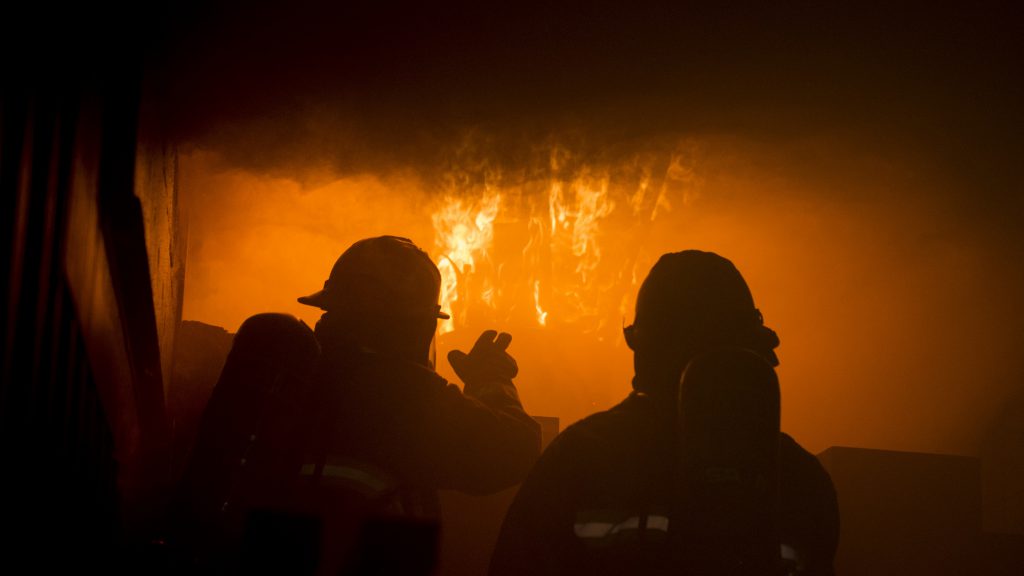
Story by Ryan White
124th Fighter Wing
Firefighters from Gowen Field participated in a unique flashover-training course, Sept. 11-13, 2019, Gowen Field, Boise, Idaho.
The course allowed for nearly 30 firefighters from the Gowen Field Fire Department and four firefighters from the Orchard Combat Training Center to perform live fire training in a controlled environment. It consisted of four hours of lecture and four hours in a specialized burn trailer.
“This is one of those training opportunities that every firefighter who goes through it remembers,” said SSgt. Reginald Pierce III, a firefighter with the Gowen Field Fire Department and primary instructor for the training.
Flashover happens when all contents in a room hit their combustion point and ignite at the same time in a flash. The training provided an opportunity to see what flashover looks like and figure out how to deal with it, how to prevent it, and how to react and escape if encountered.
“If a firefighter is in a structure fire and the room flashes, it’s near certain death,” said Pierce. “You have two seconds, as a firefighter in your full gear, to make it out of that situation before your gear fails. That’s why this training is so important.”
According to Pierce, the training helps build confidence in equipment, demonstrates what temperature ratings gear can handle and also teaches firemen how to utilize water in this type of scenario.
“For some of these guys, it’s the first time they are seeing real fire because fire school only uses propane,” said SSgt Jack Simonds, a firefighter with the Gowen Field Fire Department and assistant instructor for the training.
The live fire is done in a specialized mobile burn trailer. The upper part of the trailer is a burn chamber and the lower middle area is a classroom. A burn barrel filled with wood is lit in the center of the chamber and ignites the walls and roof, which are lined with oriented strand board. The off-gassing of the wood igniting then causes fire to rollover the firefighters’ heads as the room heats up to over 700 degrees.
“In fire school, you’re learning strategy and techniques,” said Simonds. “Here, there’s nothing about strategy and technique. All we’re doing is studying the fire. We’re not trying to fight it. We’re trying to watch it and learn from it—see how it’s going to go up the ceiling and how the heat is going to come down the wall and light on fire.”
Now that they’ve had this training, Pierce believes the firefighters will be able to quickly see signs of a possible flashover and decide if they should fight a fire defensively from the outside. Knowing those signs can be the difference between near certain death and living to fight fire another day.
Back to Newsroom
Join the Idaho Air National Guard
 Official Government Website
Official Government Website